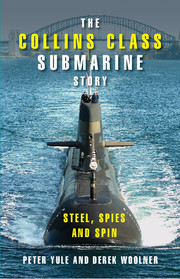Book contents
- Frontmatter
- Contents
- List of key people
- List of acronyms
- Introduction
- Part 1 You Can't Build Submarines in Australia
- Part 2 The Honeymoon Years 1987–92
- 11 ‘Keen as mustard to do a good job’: setting to work 1987–89
- 12 Designing the Collins class
- 13 Building submarines
- 14 The automated integrated vision
- 15 Steel, sonars and tiles: early technological support for the submarines
- 16 ‘On time and on budget’
- Part 3 ‘A Strange Sense of Unease” 1993–98
- Part 4 Resolution
- Notes
- Index
15 - Steel, sonars and tiles: early technological support for the submarines
Published online by Cambridge University Press: 05 September 2013
- Frontmatter
- Contents
- List of key people
- List of acronyms
- Introduction
- Part 1 You Can't Build Submarines in Australia
- Part 2 The Honeymoon Years 1987–92
- 11 ‘Keen as mustard to do a good job’: setting to work 1987–89
- 12 Designing the Collins class
- 13 Building submarines
- 14 The automated integrated vision
- 15 Steel, sonars and tiles: early technological support for the submarines
- 16 ‘On time and on budget’
- Part 3 ‘A Strange Sense of Unease” 1993–98
- Part 4 Resolution
- Notes
- Index
Summary
Science has been harnessed to support the defence of Australia since shortly after federation. In the first half of the 20th century this was strongly focused on the munitions industry and wartime manufacturing, and strong capabilities were developed in fields such as munitions chemistry, metrology, metallurgy and aeronautical engineering. After the Second World War defence science headed in new directions, with a more fundamental research program across many fields of emerging knowledge. This led to internationally significant breakthroughs such as colour photocopying and the black box flight recorder.
The ‘golden age of science’ was curtailed as the economy stuttered in the late 1970s and 1980s, leading to demands to conduct research more closely matched to the needs of the services, defence industry and various defence ‘customers’. Some activities (and even whole laboratories) were shed to the civilian sector, notably CSIRO, but a few were added. The most notable was the RAN Research Laboratories, which allowed support for naval operations to be expanded enormously. Support for ships and submarines at the Materials Research Laboratories at Maribyrnong emphasised construction and materials, integrity of structures and ancillary systems, acoustics and vibration, and propulsion.
These new directions helped DSTO provide the navy with the technical background it needed to become an ‘informed customer’ during the unprecedented ship and submarine acquisition program that unfolded after 1980.
- Type
- Chapter
- Information
- The Collins Class Submarine StorySteel, Spies and Spin, pp. 166 - 180Publisher: Cambridge University PressPrint publication year: 2008



